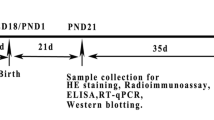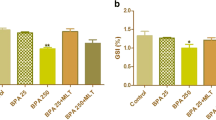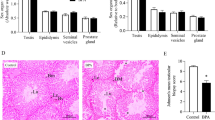Abstract
Administration of 50 μg of bisphenol A (BPA) for the first 5 days after birth resulted in a decrease in the percentage of moving sperm, and an increase in the incidence of malformed sperm, in the epididymides of mice at 10 weeks of age, although no marked changes were found in the testicular histology between BPA-treated and vehicle-treated control mice. The deteriorating effects of 50 μg of BPA were ameliorated by the concurrent administration of 100 IU of retinol acetate (RA). Neonatal treatment with 0.5 μg of BPA for 5 days resulted in an increase in the incidence of malformed sperm, whereas the BPA effect became more severe in mice nursed by mothers fed a vitamin A-deficient (VAD) diet only a few days before and after parturition. On the other hand, neonatal treatment with 20 μg of estrogen for the first 5 days after birth resulted in an increase in the number of estrogen receptor α (ERα)-positive cells in the epithelium of the vas deferens, whereas only a few epithelial cells showed weak ERα-positive signals in the vehicle-treated control mice at 18 days after birth. This increase, however, was suppressed by the concurrent administration of RA. Although five daily treatments with 50 μg BPA led to no significant increase in the number of ERα-positive cells, it may have been due to the weak estrogenic activity of BPA, as discussed. These findings clearly showed that in mice, neonatal exposure to a relatively large dose of BPA causes damage to the motility and morphology of sperm, but the BPA effect is, to some extent, inhibited by a supplement of VA, and enhanced under a VAD condition.




Similar content being viewed by others
References
Arai Y, Mori T, Suzuki Y, Bern HA (1983) Long-term effects of perinatal exposure to sex steroids and diethylstilbestrol on the reproductive system of male mammals. Int Rev Cytol 84:235–268
Atanassova N, McKinnell C, Williams K, Turner KJ, Fisher JS, Saunders PTK, Millar MR, Sharpe RM (2001) Age-, cell-, and region-specific immunoexpression of estrogen receptor α (but not estrogen receptor β) during postnatal development of the epididymis and vas deferens of the rat and disruption of this pattern by neonatal treatment with diethylstilbestrol. Endocrinology 142:874–886
Bern HA, Herbst AL (eds) (1981) Developmental effects of diethylstilbestrol (DES) in pregnancy. Thieme-Stratton, New York
Cadbury D (1997) The feminization of nature: our future at risk. Hamish Hamilton, London
Carson R (1962) Silent spring. Houghton Mifflin, Boston
Colborn T, vom Saal FS, Soto AM (1993) Developmental effects of endocrine-disrupting chemicals in wildlife and humans. Environ Health Perspect 101:378–384
Colborn T, Dumanoski D, Myers JP (1996) Our stolen future. Dutton, New York
Cooke PS, Young P, Hess RA, Cunha GR (1991) Estrogen receptor expression in developing epididymis, efferent ductules, and other male reproductive organs. Endocrinology 128:2874–2879
Danzo BJ, Eller BC, Hendry WJ III (1983) Identification of cytoplasmic estrogen receptors in the accessory sex organs and their comparison to the cytoplasmic estrogen receptor in the epididymis. Mol Cell Endocrinol 33:197–209
Greichus YA, Call DJ, Ammann BM (1975) Physiological effects of polychlorinated biphenyls or a combination of DDT, DDD, and DDE in penned white pelicans. Arch Environ Contam Toxicol 3:330–343
Hess RA (2000) Oestrogen in fluid transport in efferent ducts of the male reproductive tract. Rev Reprod 5:84–92
Hess RA, Gist DH, Bunick D, Lubahn DB, Farrell A, Bahr J, Cooke PS, Greene GL (1997a) Estrogen receptor (α & β) expression in the excurrent ducts of the adult male rat reproductive tract. J Androl 18:602–611
Hess RA, Bunick D, Lee KH, Bahr J, Taylor JA, Korach KS, Lubahn DB (1997b) A role of oestrogen in the male reproductive system. Nature 390:509–512
Hess RA, Bunick D, Bahr J (2001) Oestrogen, its receptors and function in the male reproductive tract—a review. Mol Cell Endocrinol 178:29–38
Hiroi H, Tsutsumi O, Momoeda M, Takai Y, Osuga Y, Taketani Y (1999) Differential interactions of bisphenol A and 17β-estradiol with estrogen receptor α (ERα) and ERβ. Endocrine J 46:773–778
Huang HFS, Zaidi P, Nieschlag E (1984) Pituitary-testicular interrelationship during germinal involution in the vitamin A deficient rat. J Endocrinol 100:33–41
Iguchi T (1992) Cellular effects of early exposure to sex hormones and antihormones. Int Rev Cytol 139:1–57
Iguchi T, Iwase H, Kato H, Takasugi N (1985) Prevention by vitamin A of the occurrence of permanent vaginal and uterine changes in ovariectomized adult mice treated neonatally with diethylstilbestrol and its nullification in the presence of ovaries. Exp Clin Endocrinol 85:129–137
Iguchi T, Uesugi Y, Sato T, Ohta Y, Takasugi N (1991) Developmental pattern of estrogen receptor in male mouse genital organs. Mol Androl 6:109–119
Koyama S, Kamimura S (1999) Lowered sperm motility in subordinate social status of mice. Physiol Behav 65:665–669
Kramer VJ, Helferich WG, Bergman A, Klasson-Wehler E, Giesy JP (1997) Hydroxylated polychlorinated biphenyl metabolites are anti-estrogenic in a stably transfected human breast adenocarcinoma (MCF-7) cell line. Toxicol Appl Pharmacol 144:363–376
Krishnan AV, Stathis P, Permuth SF, Tokes L, Feldman D (1993) Bisphenol-A: anestrogenic substance is released from polycarbonate flakes during autoclaving. Endocrinology 132:2279–2286
Mahato D, Goulding EH, Korach KS, Eddy EM (2000) Spermatogenic cells do not require estrogen receptor-α for development or function. Endocrinology 141:1273–1276
Masui F, Matsuda M, Akazome Y, Imaoka T, Mori T (2001) Prevention of neonatal estrogen imprinting by vitamin A as indicated by estrogen receptor expression in the mouse vagina. Cell Tissue Res 306:441–447
Matsuda M, Masui F, Mori T (2002) Toxicity of endocrine disruptor via the disruption of vitamin A metabolism. Folia Endocrinol Jpn 78:396
McLachlan JA (2001) Environmental signaling: what embryos and evolution teach us about endocrine disrupting chemicals. Endocr Rev 22:319–341
Mori T (1968) Effects of neonatal injections of estrogen in combination with vitamin A on the vaginal epithelium of adult mice. Annot Zool Jpn 41:113–118
Mori T (1969) Further studies on the inhibitory effect of vitamin A on the development of ovary-independent vaginal cornification in neonatally estrogenized mice. Proc Jpn Acad 45:115–120
Mori T, Nagasawa H (1988) Toxicity of hormones in perinatal life. CRC Press, Boca Raton, FL
Morita Y, Tilly JL (1999) Segregation of retinoic acid effects on fetal ovarian germ cell mitosis versus apoptosis by requirement for new macromolecular synthesis. Endocrinology 140:2696–2703
Morita Y, Tsutsumi O, Taketani Y (2001) Regulatory mechanisms of female germ cell apoptosis during embryonic development. Endocr J 48:289–301
Nagel SC, vom Saal FS, Thayer KA, Dhar MG, Boechler M, Welshons WV (1997) Relative binding affinity-serum modified access (RBA-SMA) assay predicts the relative in vivo bioactivity of the xenoestrogens bisphenol A and octylphenol. Environ Health Perspect 105:70–76
Nakahashi K, Matsuda M, Mori T (2001) Vitamin A insufficiency accelerates the decrease in the number of sperm induced by an environmental disruptor, bisphenol A, in neonatal mice. Zool Sci 18:819–821
Olea N, Pulgar R, Perez P, Olea-Serrano F, Rivas A, Novillo-Fertrell A, Pedraza V, Soto AM, Sonnenschein C (1996) Estrogenicity of resin-based composites and sealants used in dentistry. Environ Health Perspect 104:298–305
Robertson KM, O’Donnell L, Jones ME, Meachem SJ, Boon WC, Fisher CR, Graves KH, McLachlan RI, Simpson ER (1999) Impairment of spermatogenesis in mice lacking a functional aromatase (cyp 19) gene. Proc Natl Acad Sci U S A 96:7986–7991
Rosenfeld CS, Ganjam VK, Taylor JA, Yuan X, Stiehr JR, Herdy MP, Lubahn DB (1998) Transcription and translation of estrogen receptor-β in the male reproductive tract of estrogen receptor-α knock-out and wild-type mice. Endocrinology 139:2982–2987
Safe SH (1995) Environmental and dietary estrogen and human health: is there a problem? Environ Health Perspect 103:346–351
Sharpe RM, Skakkeback NE (1993) Are oestrogens involved in falling sperm counts and disorders of the male reproductive tract? Lancet 341:1392–1395
Spear PA, Moon TW (1986) Thyroid-vitamin A interactions in chicks exposed to 3, 4, 3’, 4’-tetrachlorobiphenyl: influence of low dietary vitamin A and iodine. Environ Res 40:188–198
Takasugi N (1976) Cytological basis for permanent vaginal changes in mice treated neonatally with steroid hormones. Int Rev Cytol 44:193–224
Tobias PV (1956) Chromosomes, sex-cells and evolution in a mammal. Percy Lund, Humphries and Co., London
van Pelt AM, de Rooij DG (1991) Retinoic acid is able to reinitiate spermatogenesis in vitamin A-deficient rats and high replicate doses support the full development of spermatogenic cells. Endocrinology 128:697–704
Yasui T, Takasugi N (1977) Prevention of vitamin A of the occurrence of permanent vaginal changes in neonatally estrogen-treated mice. Cell Tissue Res 179:475–482
Zhou Q, Nie R, Prins GS, Saunders PT, Katzenellenbogen BS, Hess RA (2002) Localization of androgen and estrogen receptors in adult male mouse reproductive tract. J Androl 23:870–881
Author information
Authors and Affiliations
Corresponding author
Additional information
This work was supported by Grants-in-Aid for Encouragement of Young Scientists, Scientific Research (C) and Scientific Research on Priority Areas (A) from the Ministry of Education, Science, Sports, and Culture, Japan
Rights and permissions
About this article
Cite this article
Aikawa, H., Koyama, S., Matsuda, M. et al. Relief effect of vitamin A on the decreased motility of sperm and the increased incidence of malformed sperm in mice exposed neonatally to bisphenol A. Cell Tissue Res 315, 119–124 (2004). https://doi.org/10.1007/s00441-003-0806-1
Received:
Accepted:
Published:
Issue Date:
DOI: https://doi.org/10.1007/s00441-003-0806-1




